Snakes in the garden are usually your friend
Views: 2824
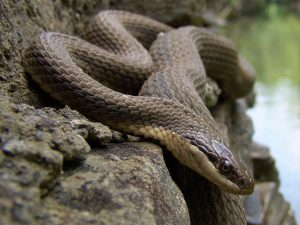
It always makes me sad when a photo of a dead snake comes across my Facebook page, usually accompanied by a message of horror from the person who posted the picture and/or killed it. Usually, it’s a harmless, nonvenomous one, and I think, “What a waste.” I grew up lifting up rocks and prying open manholes to look for snakes and scorpions and other creatures, because I think they’re fun and interesting animals. I also understand how beneficial they are to me, as a gardener. In today’s blog, I’m going to try to convince you that snakes are your friend, and also teach you how to tell the difference between venomous and nonvenomous species.
Benefits
Why are snakes your gardening friend? They play an important role in the food chain. They’re predators, so when you encounter them, they are likely out looking for something to eat. Different snakes specialize in different prey, but many harmless ones are actually hunting things that we dislike, like rodents and insect pests. People and pests go hand in hand. Whether we’re feeding ourselves, our livestock, pets, or wildlife, we create a lot of waste that attracts mice, rats, roaches and other freeloaders. And those mice, rats, roaches, and other freeloaders attract snakes.
As a gardener, if you don’t want rabbits, mice, voles, gophers, and rats eating your vegetable garden, then snakes are your friend. If you keep feed or grain on your property, they are your friend. They can get into rodent dens and holes that are too small for other predators to enter, and they will help keep rodent populations from getting out of hand. Here is a great story to illustrate this point.
Besides pesky rodents, certain snakes eat grasshoppers; others eat cockroaches, slugs, beetles, and other garden pests. Kingsnakes eat other snakes, including venomous ones, potentially protecting you from a more dangerous visitor.
I have chickens, and I lose a lot of eggs to snakes. But without the them, I know that my excess chicken feed would feed an army of mice and rats, and I’d be overrun. They help maintain a balance on my property, and I tolerate losing eggs in order to maintain that balance.
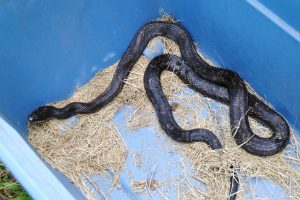
I caught this gorgeous rat snake in my hen house. Without it, I’m afraid I’d be overrun with mice.
Snakes provide free pest control without the use of pesticides. Plus, many are very beautiful!
Venomous snakes are the other side of the snakes-are-your-friend story. I have yet to see any dangerous snakes on my new property, but we saw a copperhead several times at our old place. My dog alerted me to it the first time I saw it; we had rat snakes all the time, and my dog was never frightened of them, but she recognized that this was something different. She stopped well away from it and gave a funny bark. I came to investigate because I could tell from her body language that something was not quite right, but I didn’t see the snake at first because it was camouflaged against some leaves. My dog looked at me, then looked back at the it, then looked at me, and looked back at it again, almost pointing at it with her nose. If she could speak, she would have been asking me, “Do you see it, mom?” Finally, I saw it, right in the middle of a path I walked many times a day. “Good dog!” I told her, getting both of us away safely. Somehow, she knew that this was a dangerous snake, and she warned me it was there.
All the venomous snakes in the U.S. are pit vipers except for the coral snake. These include cottonmouths, copperheads, and all the different rattlesnakes. Here’s how you, too, can tell the difference between a venomous and nonvenomous snake in the U.S.:
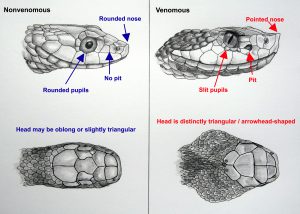
Many thanks to Deborah Carter for providing drawings for this illustration.
Venomous
- A heat-sensing pit on the side of the head (hence the name, “pit viper”)
- Slit pupils
- Pointed nose (note: the hognose snake has an upturned nose, but is not venomous)
- Triangular/arrowhead-shaped head attached to a wide, thick body
- Rattle on the tail
Coral snakes are not a pit viper so the above rules don’t apply. If you see a brightly banded red, yellow, and black snake, remember the deadly pattern is: “red on yellow, deadly fellow” or “red, yellow, STOP” like a stoplight. Coral snakes are not aggressive, nor are they often encountered. You are unlikely to see one unless you live in an area where they are established in southern coastal states.
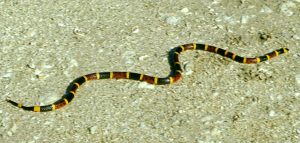
Coral snakes are highly venomous, but not common.
Nonvenomous
- No heat-sensing pit on the side of the head
- Round pupils
- Rounded nose
- From above, the head appears oblong, or slightly triangular, but is attached to a long, thin body
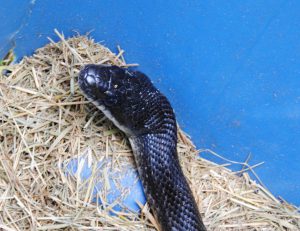
This rat snake has a slightly triangular head, but its body is fairly thin, and you can see it doesn’t have a pointed nose, pit, or slit eyes.
Many snakes will hiss or act aggressive when threatened. Rat snakes may shake their tail like a rattlesnake in the hope of scaring you off. I once ran into a hognose snake that hissed, shook its tail, and lunged at me very aggressively until I called its bluff by continuing to approach. At that point, it rolled over and played dead. I had to laugh.
The best thing to do when you encounter one is just leave it alone. As with my hognose snake, any aggression displayed is often, though not always (some water snakes are very bad-tempered), just a bluff to make you leave them alone. It’s best for you and animal to do just that.
Meet Leslie Miller
Leslie Ann Miller shares 3.5 acres in rural Oklahoma with birds, butterflies and wide variety of animals. She is currently transforming her yard with plantings…
Leslie's Recent Posts
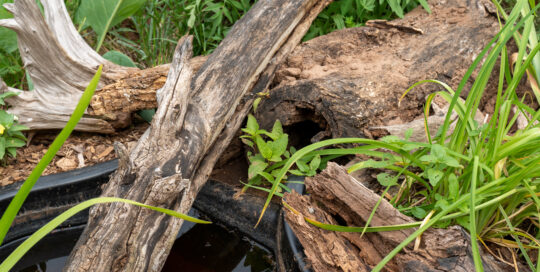
Creating microclimates and microhabitats to benefit wildlife






